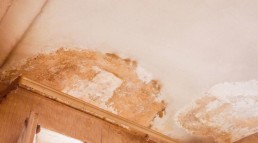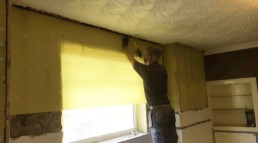Frequently Asked Questions About Penetrating Damp Issues
In the UK, both old and new properties can suffer from damp seeping through from the external walls or roof. This is due to a combination of our wet climate, building methods or defects affecting the property.
In this FAQ page we will look at what penetrating damp is, how to spot the symptoms and the most effective ways to treat this type of damp.
- What is Penetrating Damp?
- What Are Penetrating Damp Symptoms?
- What Causes Penetrating Damp?
- How Can I Treat Penetrating Damp?
- Can Cavity Wall Insulation Cause Damp Problems?
- Can Penetrating Damp Cause Health Difficulties?
- Does Penetrating Damp Cause Black Mould?
- Can You Treat Damp Using DIY Solutions?
- Is Penetrating Damp Covered by Home Insurance?
What is Penetrating Damp?
Penetrating damp is the ingress of moisture through the external envelope of a property, walls or roof of a building, due to poor construction or property defects.
Rain penetration is one of the most common forms of water ingress that leads to damp affecting properties. The external of a property is designed and built to stop water and damp penetrating and affecting the fabric of the property. If any of the external material become defective or damaged then this can allow damp to penetrate. The consistent contact between water and damaged masonry saturates the wall and can allow ingress of moisture through the wall and affect the property fabric and structure. The water can seep through until it reaches the internal wall and this can occur at any level in your property.
Cavity wall insulation can also cause penetrating damp when an inappropriate insulation material is installed or the insulation becomes wet. In some cases, cavity wall insulation soaks the damp penetration becoming a damp bridge between the external and the internal leaf of the cavity wall. However, older property are also susceptible to penetrating damp, as they were often built with solid walls. Properties located in coastal areas, or in exposed locations are also at higher risk, due to the potential high levels of driving rain in these areas.
At Richardson & Starling we have experienced surveyors who can help identify the cause of damp affecting your property and help you find the best damp penetration treatment for your home.
What Are Penetrating Damp Symptoms?
The symptoms of penetrating damp will vary depending on the severity of the problem, but can include any of the following:
- Water marks developing on internal walls, which grow with increased rainfall
- Damp patches on walls or ceilings
- Water droplets or free flowing water on inside surfaces
- Growth of black mould on damp surfaces
- Damaged, blistering plaster
- Musty smell
- Discoloured patches
- Rotting floor timbers or skirting boards
Symptoms of penetrating damp are not only visible on the inside of a property. External darker patches on the exterior walls, damaged brickwork, or small plants and moss taking root on the damp masonry can be indicators of penetrating damp.

What Causes Penetrating Damp?
The most common causes of penetrating damp are exterior building defects. Over time, materials deteriorate or become damaged due to extreme weather such as high rainfall, storms or frost. As the exterior of a building degrades this can cause penetrating damp without the correct maintenance and repairs.
Building defects that can cause penetrating damp include defective roof coverings, leaking rainwater pipework, faulty joints between windows and walls, blocked window seal run-offs, degraded pointing and render, damaged brickwork, defective waterproofing and cracked walls.
When dealing with penetrating damp it is always best to seek professional advice and help. Trying to apply your own penetrating damp treatment can cause further damage to your property if the wrong repairs are done.
How Can I Treat Penetrating Damp?
The first step to penetrating damp treatment is to have a survey conducted. Our specialist teams at Richardson & Starling are hugely experienced in conducting damp surveys and have seen all levels of damp and the damage it can cause.
Once the cause of damp has been identified, traditional building techniques alongside the latest products and repair systems will be used to treat the damp and rectify the damage.
We also offer to repair and rectify any decorative damage, such as replacing damaged plaster and where appropriate apply a preventative fungicidal treatment. We provide a five-year penetrating damp guarantee for your peace of mind that the appropriate repair has been done. Please note that most property preservation contractors do not provide any guarantees for such repairs.

Can Cavity Wall Insulation Cause Damp Problems?
Cavity walls were first installed in the early 1900’s to improve property design, performance and help tackle damp in properties, but since insulation has been used to fill the cavity it has, in some cases, caused damp problems.
Where insulation has been incorrectly installed, or an incorrect material has been used, it can cause damp bridges between the external and internal wall, allowing damp to transfer across the cavity wall.
If cavity wall insulation is causing damp, it can be removed, but we would always recommend seeking professional help. Our specialist team of damp proofing specialists can survey your property and remove cavity wall insulation where required.
Can Penetrating Damp Cause Health Difficulties?
Living in a damp environment for an extended period can cause health problems. Damp will cause cold patches on the walls, which can lead to condensation and the growth of mould. Mould can be an issue if left untreated and allowed to spread, especially for anyone suffering with respiratory problems.
Does Penetrating Damp Cause Black Mould?
Black mould only grows on wall surfaces that are affected by condensation. However, the cold surfaces on the interior walls of a property caused by penetrating damp are highly susceptible to moisture condensation.
Alongside issues with damp, poorly heated and ventilated properties and basements with inadequate waterproofing are also ideal environments for mould.
If you are concerned about the growth of black mould in your home, our specialists can help provide the right damp proofing solution.

Can You Treat Damp Using DIY Solutions?
Self-diagnosing damp can become costly, as the wrong diagnoses and treatment or the problem left untreated can cause structural damage to your property.
At Richardson & Starling we have surveyors with years of experience that can help find the most effective penetrating damp treatment for you home. So, we would encourage anyone who is inclined to do DIY works to get in touch with a specialist damp proofing company first to get the appropriate advice.
Is Penetrating Damp Covered by Home Insurance?
Penetrating damp is considered to be caused by property defects and should be dealt with as part of the maintenance of a property, therefore it is generally excluded from home insurance.
Our best advice is to check with your insurance provider for clarification. If you are concerned about penetrating damp in your home, contact us today – we can offer specialist advice and guaranteed penetrating damp treatment solutions.